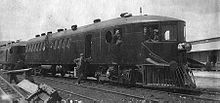McKeen railmotor
| McKeen Railmotor | |
|---|---|

McKeen railmotor in Wodonga, Australia, 1911.
|
|
| Manufacturer | McKeen Company of Omaha, Nebraska, U.S.A. |
| Designer | McKeen Company |
| Constructed | 1914 |
| Number built | 152 |
| Specifications | |
| Car length | 55 ft (16.76 m) and 70 ft (21.34 m) |
| Prime mover(s) | Gasoline |
| Engine type | Petrol engine |
| Cylinder count | 6 |
| Power output | 100 hp (75 kW) |
| Track gauge | 3 ft 6 in (1,067 mm), 4 ft 8 1⁄2 in (1,435 mm) and 5 ft 3 in (1,600 mm) |
| ABCL cars | |
|---|---|
| Manufacturer | Victorian Railways |
| Specifications | |
| Car body construction | Steel |
| Car length | 66 ft (20.12 m) over body, 69 ft 5 1⁄8 in (21.16 m) over coupling points |
| Width | 9 ft 6 in (2.90 m) |
| Height | 11 ft 9 3⁄16 in (3.59 m) |
| Weight | 24 LT 16 cwt 3 qtr (25.24 t) |
| Bogies | 40 ft 2 in (12.24 m) centres; 9 ft 5 in (2.9 m) former engineroom end bogie; 9 ft (2.7 m) former passenger-end bogie; 44 ft 7 in (13.59 m) total wheelbase. |
| Track gauge | 5 ft 3 in (1,600 mm) |
The McKeen Railmotor was a 6-cylinder self-propelled railcar. When McKeen Company of Omaha, Nebraska, U.S.A. first unveiled the car in 1905, the McKeen was among the first engines with a gasoline-powered motor. Revisions to the McKeen car led to the modern self-propelled gasoline rail-motor vehicle, and the "contours of the porthole windows, the front-mounted gasoline engines, and other features anticipated the streamline concept."
William R. McKeen was the superintendent of motive power and machinery at Union Pacific Railroad in 1904 when Edward H. Harriman, the head of UP, began encouraging him to develop the machine. The result of his experiments that year was a "knife-nosed" or "windsplitter" unit that slightly resembled a submarine on wheels, having a distinctive pointed nose, a rounded rear end, center-entry doors and porthole windows. Two lengths, 55 and 70 feet (16.76 and 21.34 m), were offered, and both could be configured with either a large mail and express area ahead of the center doors, a smaller mail and express area, or fully fitted with seats, which provided a maximum passenger capacity of 64 or 105 respectively. Cheaper and more powerful than battery-powered vehicles, the McKeen was more flexible than steam locomotives and could operate at competitive speeds.
The McKeen was popular from 1915 through the 1930s throughout the United States, and the cars were featured on the Union Pacific and the Southern Pacific.
Two McKeen railmotors were purchased and delivered to the Victorian Railways in Victoria, Australia in 1911. They served throughout their life as a railmotor they ran the Ballarat to Maryborough and Hamilton to Warrnambool services, and briefly in March and April 1913 on Maryborough to St Arnaud services.
...
Wikipedia
